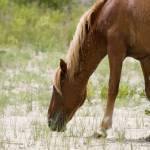Managing Horses in the Desert

Desert conditions provide special challenges to horse owners and managers. Despite the lack of natural water and forage, desert environments can be a viable option for keeping horses.
The primary concern in most desert environments is heat stress. Many horse owners manage this by only turning out or exercising horses during cool morning and evening hours, then moving them to well-ventilated and shady stalls during the heat of the day. If stalls aren’t available, a run-in shed or thick stand of trees can also provide relief from the sun’s scorching rays.
Owners of desert-dwelling horses must be familiar with and able to recognize signs of heat stress in their animals. Clinical signs can include profuse sweating, accelerated heart rate, and rapid breathing. This can quickly progress to heatstroke, which is characterized by high pulse and respiratory rates, as well as a rectal temperature of 104 degrees Fahrenheit (40 degrees Celsius) or higher. If a horse is showing these clinical signs, it should be continuously hosed down with cold water until a veterinarian arrives.
Hydration is also crucial in hot environments. Horse owners in these areas must always provide fresh, clean water. Automatic waterers should be constantly monitored and frequently maintained; broken valves and short circuits can quickly cause a tank to dry up. Some owners prefer to use troughs and buckets filled by hand in order to eliminate this possibility and monitor each horse’s intake.








